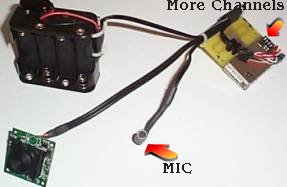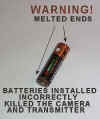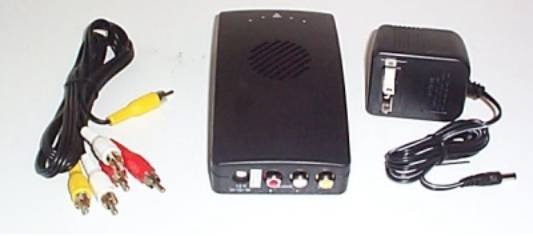|
|
||

|
||
|
WWW.SPYSHOP2000.COM
The
CCD camera on your system is consuming power. When power is consumed
heat is generated. Your camera will get very warm and sometimes hot
during operation. This is normal. This is not a malfunction. Make
sure your putting the batteries just like the little pictures in the
clip say. There
is a switch on the battery pack. This is the power switch. One-way is on
and the other is off. You will know when you have the power on because
the little light on the transmitter will light up. Notice
that the camera and the microphone have very tiny plugs so that they can
be removed from the system. These are very fragile. This is a delicate
system. Please treat it gently. You can remove the camera or microphone
when you’re not using one or the other. On
the camera at the top of the lens there is a very tiny screw. This is a
setscrew. It holds the lens from turning. You can fine-tune the focus of
the camera by loosening this screw and rotating the lens in either
direction. This camera has a great focal range so you shouldn’t
need to make changes. The lens is in there pretty tight so it may be
a little hard to turn. If you decide to adjust it do so in very small
increments.
The
color-coded plugs are known as RCA type plugs. The
plugs on the cable and the receiver unit are color coded to make this
really simple. Unfortunately not all manufactures follow the standard
color code. The video output of the receiver unit is labeled VIDEO. On
your TV or VCR there will be a VIDEO INPUT. You need to connect the
video of the receiver to the video input of your TV or VCR. If you got a
system with out audio the patch cord that you received might not be the
same color as the plug on the receiver. Simply ignore the color of the
patch cord and pay attention to the color of the video plug on the
receiver and your TV or VCR. If
you got a system with audio then your patch cord color will match the
colors of the plugs on the receiver.
Connect one end of the yellow patch cord to the video on the
receiver and the other end to the Video on your TV or VCR. The red and
white patch cords are for the audio. Connect one end of the red patch
cord to the receiver and the other end to your TV or VCR’s audio
input. Connect one end of the white patch cord to your receiver and the
other end to your TV or VCR’s other audio input. Some TV’s and
VCR’s only have one audio input. If this is the case on your TV or VCR
then leave the white patch cord unplugged on the TV/VCR end. Now
for the hard part… Now
that your receiver is connected to your TV or VCR we need to figure out
how to see the images coming from your camera. For testing purposes
it’s best to start by connecting the receiver to your TV and not to
your VCR. You might want to
get your TV manual out for this part. In
order to see the video coming from the camera we need to find out how to
select the video input source on your TV that we just got through
hooking the receiver unit to. To get to the video source on most TV’s
you keep pressing the channel down button until your one or two clicks
below channel one. Most TV’s will display “VIDEO 1” or VIDEO 2”
when you’re on the video input source. Every
one of these systems is tested right before they are put in the box to
ship to you so we know that they worked when we shipped them. In most
cases when we get a system back because someone thought the system
wasn’t working, it works when we get it. With that in mind you need to
be sure that you have tried everything before jumping to the conclusion
that the system is not operating properly. Now
that you have the system working and you can see the video on your TV,
lets get it working through your VCR. Follow the same steps used to
connect the receiver to your TV only now connect the receiver to your
VCR. Connecting
the VCR to the TV with RCA patch cords: You
will do this just like we did with the camera receiver. Connect the RCA
video output of the VCR to the RCA video input of the TV. The TV should
already be set to its video input because we just had it working with
the camera. Put videotape in the VCR and press play. You should see the
movie on the tape playing on the TV. Now you know that the TV is
receiving video from the VCR. Skip the next section on using coax to
connect your VCR to your TV. Connecting
the VCR to the TV with coax: Screw
on end of the coax cable on the RF out of the VCR. Screw the other end
on to the RF in on your TV. Put videotape in the VCR and press play. Set
the TV to channel 3 or 4. You should see the movie that’s on the
videotape playing. Now you know that the TV is receiving video from the
VCR. You have to know this before we try to see the video from the
camera. Now
that we know how to see video from the VCR on the TV we need to know how
to see the camera video through the VCR. Just like your TV the VCR has a
way to select video from its external video input. Just like your TV
using the channel down button on the VCR usually does this. The external
video source is usually one or two clicks just below channel one. Just
like your TV the video input source of the VCR might be selected by
pressing a button on the VCR or its remote labeled “VIDEO 1” or
“VIDEO 2”. You may need to get out your VCR’s manual to figure
this out. This
is really far simpler that it might seem. Be patient. Read through these
instructions several times before giving up. The main thing it to start
with just the TV so you know that the system is working and with that
knowledge you will know that it’s just a matter of figuring out how to
get the video working through the VCR.
One you have the video working through the VCR to your TV you can
record the video on videotape and pay it back though the TV. If you
still need assistance you can find our contact information on our
website at www.spyshop2000.com
under the contact information link. Were her to help so feel free to let
us know if your having trouble. Again please make sure you have tried
everything before jumping to the conclusion that the system is not
working properly. This is extremely rare. These
are delicate systems. The most common cause of system failure is caused
be letting the camera or transmitter electronics come in contact with
each other or some other object that shorts out the system. If you
didn’t order the shrink-wrap option we strongly recommend that you
protect the system with electrical tape or some other method. If a
system fails due to shorting it’s obvious when tested. If this is the
case we will not repair or replace your system with out charge. Please
be extremely careful to prevent shorts. If you would like to purchase
the shrink-wrap option, you can send your system back to us and we will
add the shrink-wrap for you. All systems are tested upon arrival for
proper operation. If your system is not operational when we get it we
will immediately ship it back to you. You will need to pay for the
upgrade and return shipping before sending the unit to us.
You will need to obtain a return merchandise authorization number
before shipping the unit to us. Any package shipped to us must have this
RMA number or the system will be returned to sender and you will have
wasted shipping expenses. BUG
PLUG INSTRUCTIONS Attaching
the BUG BLUG to the transmitter: Simply remove the connector from the
top of the battery pack and line up the connector from the transmitter
with the connector on the BUG PLUG. ACCESSORIES If
you didn’t get the audio upgrade with your video bug at the time of
purchase you can upgrade at any time. This will require you sending your
system in. All systems are tested upon arrival for proper operation. If
your system is not operational when we get it we will immediately ship
it back to you. When doing an audio upgrade you will need to pay for the
upgrade and return shipping before sending the unit to us.
You will need to obtain a return merchandise authorization number
before shipping the unit to us. Any package shipped to us must have this
RMA number or the system will be returned to sender and you will have
wasted shipping expenses. Portable
power for your receiver unit: Don’t
go getting yourself in trouble when using this system. Capturing audio
of someone with out letting them know first is illegal in most states.
If you have doubts then remove / unplug the microphone from the end of
the audio cable. That’s why its there. Also capturing video of anyone
in a place where they might expect a reasonable amount of privacy like a
bedroom, bathroom or dressing room is illegal in most areas, even in
your own home. Now
for some real legal mumbo jumbo:
|


